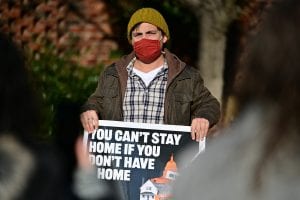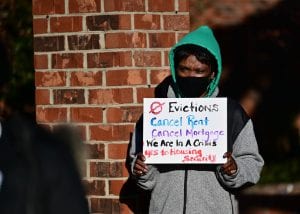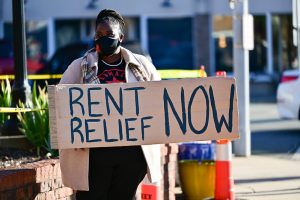Emily Benfer is a professor of law at Wake Forest University, chair of the American Bar Association’s COVID-19 Task Force Committee on Eviction, and co-creator of The Eviction Lab COVID-19 Housing Policy Scorecard. Over the past year she’s been called upon as an expert on the current state of evictions by outlets from NPR to C-SPAN to Fox. Shelterforce spoke with Benfer in mid-February about how she came to be a go-to voice on the eviction crisis, the connections between health and housing, and what needs to change in our housing and eviction systems—not just now, but once the pandemic is past.
The following transcript has been edited for length and clarity. Watch the full interview here.
Miriam Axel-Lute: How did you get into housing law?
Emily Benfer: Before I went to law school, I was working at a Legal Aid office in Connecticut. From that early point, it was so clear that housing was paramount to livelihood, that it was one of the pillars of resiliency.

Emily Benfer
I was collecting evidence around housing code violations, and I would go into families’ homes and take pictures of mold and infestations and other problems. Everyone was sick, and everyone needed legal assistance to remedy those things that were causing their illness.
That really inspired a legal career. I started working with families who are homeless in Washington, D.C., and saw firsthand the extent of harm that eviction and housing displacement causes for families, and how homelessness itself sets you on that downward trajectory of poor health and barriers to opportunity.
All of those experiences really led to this moment of understanding the injustice in the eviction system itself, the imbalance of power, and the extreme harm that families and individuals face for as little as being a few dollars behind or a few days late on the rent.
Brandon Duong: How do you see public health, law, and poverty relating to one another?
Poverty is a social determinant of poor health. And the conditions of poverty often lead to poor health outcomes for families and individuals who are facing economic instability or distress. Public health laws are able to regulate many of the conditions of poverty, like substandard housing conditions, the environments that people live in. Housing law is also implicated here in terms of the historic effects of redlining and how we’re investing in communities. All of these fields are connected, and in the same way that social issues are—they are a Gordian knot. You cannot isolate them and expect to unravel it; you have to look at the whole.
One of the areas that I focus on pretty heavily is health justice. This is really an attempt to try and understand the social roots of health inequity and address subordination of historically marginalized groups, especially people of color [and] people in poverty. A health justice framework looks at discrimination—both on a systemic and interpersonal level—but also [at] the laws and policies that are in place because of that discrimination and that subordination.
Law is truly a determinant of health. You literally can’t cross the street without walking through a law or some sort of regulation that’s governing and dictating your behavior. And in the same way, law determines the type, the quality, [and] the access to housing.
Duong: One of the problems with the recent CDC eviction moratorium is the inconsistency in how judges are interpreting it. Could you talk about that issue?
The CDC moratorium is a really good example of [when] public health and housing intertwine. It is a pandemic mitigation strategy designed to keep people in their homes so that we can control the spread of COVID-19. That is only effective if it’s consistently interpreted across jurisdictions, if it’s implemented uniformly, and if it’s enforced. It also requires that tenants understand their rights, because they are the only individuals who can trigger protection under the moratorium.

The Candler County Courthouse in Georgia. Some judges in the state believe the CDC’s eviction moratorium is unconstitutional. Photo by Richard Chambers, via Wikimedia Commons
We’re seeing varied interpretations of the moratorium itself from the courts, and as well as from property owners, [in terms of] their willingness to accept the declaration, and sheriffs on the end of the system, who are charged with executing orders of eviction. In some jurisdictions, we have very protective courts [that] have determined that presenting a declaration under the moratorium will stop the filing of the eviction itself, keeping it off your record, keeping you out of the court system. In other jurisdictions, they’ll allow the process to proceed all the way to the execution of the order, halting it right there, as opposed to earlier in the process, which [would] give you more time to collect rent relief, to avoid a judgment, to avoid that scarlet “E” on your record.
We also have judges in Georgia, for example, who have determined that the CDC moratorium, in their opinion, is unconstitutional, which contravenes higher-level court decisions that have already decided [the moratorium is] a necessary measure during the pandemic and that it is not infringing on any constitutional rights. The various interpretations have led to inconsistent implementation and really limited the effectiveness of the moratorium in preventing the spread of COVID-19.
The eviction system and the laws governing eviction are determined state by state, and they even vary sometimes from county to county. In some states, magistrate judges who only need a high school diploma are deciding those cases. In other states or cities, the court is overseen by a judge who has to have a law degree, and their only practice is housing law. It’s incredibly different across the country—everything from how easy it is to file a case to the extent of due process a tenant receives.
Axel-Lute: What could be done at the federal level to deal with this inconsistency?
When the moratorium was first issued [in September 2020], it was very broad. It appeared to apply to all stages of eviction and to the vast majority of tenants facing nonpayment of rent eviction. A month after it was issued, the CDC issued guidance, an FAQ, that really eroded those protections. [It] allowed landlords to file cases and [to] challenge the veracity of a [tenant] declaration.
This had the effect of turning eviction court into a perjury trial. That is incredibly harmful and incredibly intimidating for tenants, and [it] has a chilling effect on an individual’s willingness to actually exercise their rights under that moratorium to stay safe during the pandemic. It also led to loopholes and violations of the moratorium, as well.

A rent relief protest in North Carolina in January. Flickr photo by Anthony Crider, CC BY 2.0
The CDC and Congress can correct that immediately by rescinding the FAQ, which does not have the force of law. It should only be considered by courts when there’s a question on the face of the order, and there isn’t. The order itself is extremely clear.
[We need] to make it clear that the CDC moratorium applies to all evictions, to all stages of eviction, so that it stops the initiation of the eviction itself. We know that pre-pandemic, over 30 percent of tenants vacate[d] their unit at the first sign of eviction. If we allow those filings to go forward, we will still see the spread of COVID-19 because tenants don’t want to engage with the court system. They will start doubling up with friends and families, be transient, and [be] unable to comply with pandemic mitigation protocol.
Right now, we’re seeing many property owners use reasons beyond nonpayment to move forward with [an] eviction that’s truly based on lack of rent payments, such as staying beyond the lease period, or some lease violation that would have been overlooked in pre-pandemic times. Also [there’s a] spike in self-help, or extrajudicial, evictions across the country.
Axel-Lute: What sort of enforcement power could the federal government bring to bear if a judge continues to let evictions proceed in clear violation of the order?
Especially the most egregious cases, such as Georgia, where the magistrates are declaring the unconstitutionality of the moratorium, the Department of Justice needs to enforce that order and ensure that these states are adopting it.

A rent relief protest in North Carolina in January. Flickr photo by Anthony Crider, CC BY 2.0
Also [we found] the vast majority of states, about 46, have yet to formally adopt the CDC moratorium. If a governor issues an order adopting a moratorium in the state, then there’s no question that the CDC does have authority in that jurisdiction. That is another way to increase enforcement opportunities.
Another piece is education. Tenants must know their rights going into the process. In many states, the moratorium is being used largely as an affirmative defense that you raise after the case has been filed. That requires that a tenant be knowledgeable about how to do that and when in the process to do that, and that [it] is their right to do, as well.
Because so much of this has to do with this complicated legal system, it’s critical to have legal representation. We know that in cities that have a civil right to counsel in housing court, evictions are reduced dramatically. New York City ZIP codes that added a right to counsel went from only 1 percent of tenants (and 95 percent of landlords) having representation to the majority of people facing eviction being represented; 84 percent of those who were represented avoided eviction. The shift in outcomes truly demonstrates the injustice and the bias inherent in the system, and the need for legal representation to rectify that tilt.
Duong: Are there any executive orders or other actions that you think President Biden could make that would help in mitigating the current eviction crisis?
There are a number of executive orders that have already been issued that could be levers to address the eviction crisis. For example, [in] the new administration, one of the first executive orders that was signed was about racial equity in underserved communities. And eviction is exactly that.
Across the country in low-income communities and communities of color, housing [problems] and eviction [are] affecting people of color at dramatically higher rates, both before the pandemic and during the pandemic. Black households are telling the U.S. Census that they are at risk of not being able to pay their rent at twice the rate of white households in this moment during the pandemic. Pre-pandemic, Black households were also two times as likely to be evicted than white households, even after controlling for education. And this phenomenon affects Black women and families at the highest rates. And so, that executive order about achieving racial equity in underserved communities is directly implicated in this issue.
What we really need in this moment is direction from Congress, [which] has the authority to extend the [CDC eviction] moratorium for the duration of the pandemic, [and] to ensure that households receive rental assistance to cover the back rent owed, and to make up the rent burden.
There are a number of actions that can take place, but the most important in this moment is a uniform moratorium that applies to all evictions across the country and to all renters who are at risk of displacement and doubling up. And at the same time, rental assistance to ensure that when this crisis is over, we aren’t walking into a proliferated affordable housing crisis and homelessness crisis throughout the country.
Axel-Lute: At the moment, we have a little bit of rental assistance. As often happens when there’s a limited amount of funds, there’s some tension about how to spend what we do have and how to prioritize it. What’s the most equitable way to approach spending the rent assistance money that we have?
First as a country, we have to dedicate more funds to addressing the eviction crisis. It’s estimated that tenants owe upwards of $100 billion in back rent, and we only have $25 billion earmarked for rent and utility debt. That $25 billion is only going to make a dent in the need. How effective it is depends entirely on how committed states are to dispersing the funds that they receive in a deliberate and equitable way.

A protestor holds a “Rent Relief Now” sign during a North Carolina demonstration in January. Photo by Anthony Crider via flickr, CC BY 2.0
Many states did not have robust rental assistance or rent relief programs before the pandemic, so they are building them from scratch, which means they don’t have inroads into the communities that need them the most. If they learned anything from the CARES Act and the CRF [Coronavirus Relief Fund] funding and some of the failings of those programs—the bar was set too high so they had excess funds that [were] never disbursed to the community, or the bar was set very low and they ran out of funding within hours—[it should be that we] need to get that funding into the communities as quickly as possible to prevent the most harm.
A couple of the best practices for rental assistance programs [include] ensuring that the barrier to entry is very low, that there are not rigorous requirements for eligibility and proof of eligibility, that the bar doesn’t create some sort of deterrent for people who are extremely marginalized or who might be undocumented, [and] that families and individuals targeted [for aid are] at the highest risk of extreme harm.
The low eligibility bar is the first step. The second is really identifying trusted community partners that the community works with already [who] know where to find the hardest-hit renters and how to get the funds to them quickly. That’s a very critical component of this.
We know where people are hardest hit. It’s the same communities that have been ignored and overlooked for decades. It’s the communities with the lowest incomes, with the highest poverty rates, with the least amount of access to opportunity, and with the highest population of color.
We can target our funds into those communities first to really build them back up and ensure that they’re not at risk of displacement in the way that they are right now.
Another approach is to also partner with the courts [to ensure] that before a landlord can file [for eviction] they have identified rental assistance programs and given that information to their tenant. In some places the landlord can apply themselves for that rental assistance and receive it directly. Make sure that the courts are aware of that information and become one of the delivery systems so that the rental assistance gets to the people who are the closest to that eviction system itself.
The other issue, though: Even if Congress allocates all of the funds that are critical in this moment to prevent the current crisis, that’s not going to be enough to address the underlying affordable housing crisis. Coming into this pandemic, we had stagnant wages for decades. The lowest-income wage-[earner]s actually lost 5 percent of their income. We had stagnant wages for the middle class. We had rising rents with few states with rent caps, and we had a dearth of investment on the part of the federal government into affordable housing. And we also lost four million affordable housing units in the decade leading into the pandemic.
So unless we have a commitment to addressing those root causes and actually investing in communities [that] entered the pandemic in a deficit, we will not address the looming harm that we are on the brink of seeing in the future.
Duong: Do you think it’s better to have broader eligibility to cover everybody, or to target the limited resources to people who need it the most?
We need more resources. The approach has to be to cover anyone who’s at risk of eviction. Let’s be clear: the people who are facing eviction have the highest rates of comorbidities [that] would result in complications and higher rates of death. The people facing eviction right now are at higher risk of COVID-19 mortality than other populations because of those existing conditions that we see in lower-income populations and people who have low wages and job loss.
So we need to cover everyone. That has to be our standard of practice.
Axel-Lute: Do you have thoughts about the role of nonprofit housing providers in this ecosystem?
There is a real risk that, without federal intervention in the form of tax breaks and moratoriums on foreclosure and other issues related to the ability to provide housing itself, either as a private landlord or as a nonprofit landlord or a federally funded one, we will see a reduction in affordable housing in the housing market even beyond what has already happened in the last decade. And without that housing, there is no other outcome beyond widespread homelessness doubling up. This pillar of resiliency is completely wiped out.

A volunteers unloads and prepares vegetables for distribution at the food pantry operated by St. Luke’s Episcopal Church with the support of The Neighborhood Developers. Photo courtesy of The Neighborhood Developers
I’m starting to see the federal government include in proposals more relief for property owners, for nonprofit housing owners, for individual owners to try and address this looming issue of taking these units off the market and being forced to evict tenants. Unfortunately, it really comes down to our budget.
[Related: During the Pandemic, Community Development Organizations Prioritize Relief and Assistance Work]
The fate of the housing market and the long-term health and well-being of renters across the country is resting on the shoulders of the people hardest hit by the pandemic. And we can’t expect them to carry that burden. There has to be a nationwide commitment to addressing the eviction crisis and the underlying affordable housing crisis, supporting the housing providers, as well as buoying the tenants who need that support so critically right now. And that requires a federal commitment.
Our budget is a moral, ethical document, and we will be deciding what the country actually stands for.
Duong: What should we change about the housing system long term, after the pandemic?
The affordable housing issue is born of the lack of racial equity and support for underserved communities. It is directly linked to decades of racially discriminatory housing laws and policies that were left to stand and their aftermath left unaddressed. We can directly attribute the lack of wealth accumulation, the lack of homeownership, the lack of opportunity for communities of color across the country [to racially discriminatory housing laws].
We have to address that affordable housing crisis, which is largely attributed to those stagnant wages, rising rents, and lack of federal investment. That’s also going to require that the government-sponsored enterprises start investing in those communities. They were responsible for the current market conditions, and they are responsible for ensuring that racial disparities and asset accumulation are addressed. And that means that mortgage lending and the siting of homes must become a priority.
The other piece is ensuring that all of these different sectors that have any kind of nexus with housing and community development be engaged, and that we look to unlikely partners, from health care institutions to larger lenders, to really start investing in communities where they haven’t traditionally.
On the eviction system itself: we have an eviction system [which], for just being a few days or a few dollars late on your rent, can take years off of your life. It can cause adverse outcomes for pregnancy—[like] low birth weight [and] early-term pregnancies. It leads to increased violence for women. One eviction usually means that you will have multiple evictions and future housing precarity.
All of this harm is due to the singular event of being caught up in that eviction system. And the system itself is being abused. Landlords are using it to control behavior, to remind tenants to pay rent. They’ll file cases against them multiple times. This serial filing phenomenon ends up increasing rents for tenants and placing them at even further housing precarity.
The system itself has to be addressed. Many of the solutions we are placing on it right now are Band-Aids. The system itself is inequitable, so any of these solutions will not address that harm unless we take a look at the underlying issues. And a big part of that is power imbalance.
Our landlord/tenant laws are descendants of feudal law, where tenants had no rights other than to pay the rent. Landlords could rent to whoever they want. They could discriminate. They could engage in self-help eviction. They could provide uninhabitable units.
And so, today, while we have more protections for tenants, we have a long way to go. It’s too easy to file an eviction case, and our eviction system, which was originally designed to allow the property owner to recoup the property, is now largely a debtor court.
In almost every jurisdiction across the country, a landlord can file to evict for no reason. At the end of your lease term, they only need to give you 30 days’ notice to evict. And that is a mask for discrimination, for retaliation, and can really lead to a wide level of injustice.
We need to start thinking about eviction prevention [and] diversion programs, just cause eviction, where there has to be a legitimate reason for evicting a tenant, and clean hands policies—you should not be allowed to evict a tenant from your unit if that unit is not habitable, if it does not comply with housing code and sanitation code.
At the same time, the phenomenon of the scarlet E is so harmful and damaging. An eviction is a legal record, that no matter the outcome of the case, even if a tenant wins, is still searchable for a long period of time. It haunts that tenant when they’re trying to put their life back together, and it pushes them to the outskirts of the rental market because landlords will screen out tenants who have an eviction on their record. Even public housing authorities will often screen them out. And again, it may just be for that small amount of rent owed, and was solely for the reminder that your rent was due.
[Related: Eviction Filings Hurt Tenants, Even If They Win—Sealing Records Can Help]
We have to start redacting the record, sealing records, ensuring that this can’t haunt a tenant and destroy their lives.
Ensuring stable housing has to be a national priority. And a part of that means really considering the right to housing. This is not revolutionary. We have multiple countries across the world, from France to Scotland to South Africa, [that] had a right to housing. Homelessness in Scotland, for example, is something that doesn’t happen very often. And when it does, it’s rare and it’s short in time duration.
We need to start thinking about that in the United States. This right to safe and decent housing across the country is something that we’ve promised people for decades. In 1944, the Economic Bill of Rights included the right to stable housing. And in 1949, the Housing Act set as the national goal the realization, as soon as feasible, of the right to a safe and decent home for every family in the country. It’s about time those rights are realized. If we don’t, we’re just setting ourselves up for further public health crises in the future.
Axel-Lute: There are a lot of health systems, health players, hospitals, and insurers who have been putting investment into affordable housing on the supply side. Have you seen any of them also move into sticking up for better tenant protections?
The medical and public health fields are extremely well-versed in the health connection with housing. They recognize the overwhelming evidence that [shows that] eviction leads to severe poor health outcomes, higher mortality rates, respiratory distress, cardiac disease, drug use, STDs, depression, anxiety, mental health issues, suicide. The list goes on and on. There’s no good outcome from eviction and from housing instability, especially for children. We’re seeing a lot of pediatricians really engage in housing. They recognize the link between eviction and an increase in lead poisoning, which results in permanent brain damage; in respiratory disease; in academic decline; in food insecurity. All of these pillars of childhood that allow a child to thrive and grow are stripped from them.
[Related: Health Care Institutions Invest in Tenant Protections for Community Health]
In response to that, we see providers testify at city council hearings. A group of about 24 medical associations and public health associations across the country filed an amicus brief in the challenges to the CDC moratorium at the federal level. But we need to keep moving in that direction. There can be much more advocacy and outreach.
The other piece where I’m seeing a lot of this is in the increase in medical-legal partnerships. Many of those medical-legal partnerships, where a lawyer is integrated into the health care team, focus heavily on housing, especially housing conditions and eviction prevention.
Health care providers are crucial to achieving the policy change that’s necessary in this area. Policymakers will listen to health care providers [because] they are an authority on this topic. When they present these issues, there are results.
Duong: What do you think the national conversation around housing stability and eviction will be now that we’re starting to move out of the pandemic? Do you think we’ll be talking about housing as a health issue beyond COVID?
It’s hard to say because I’ve always seen it as a health issue. It’s always been so clear to me that unstable and unhealthy housing is directly linked to poor health outcomes and a person’s ability to thrive and access opportunity. It’s been incredibly encouraging to see that link elevated to such a high level during the pandemic and the recognition that housing is health care, housing is health be widely accepted. Hopefully this will shift our understanding of the importance of housing to all of these other areas of life and how deeply linked they are. But time will tell.
Duong: Do you think there’s anything that housing advocates can do to keep it in the public eye as a major issue?
The other piece of the pandemic that I’ve noticed is housing advocates are using health-based arguments much more frequently and seeing success because of that. It is my hope that this will continue, that we will start to integrate that into our practice of law in this area into the future, as well.
When I directed a health justice clinic in Chicago, many of our cases were eviction cases. We had 100 percent positive outcome; in each case, we were able to get the security deposit and back rent to the tenant because of the conditions of those units. We had the medical provider testify on behalf of those tenants, demonstrating the link between housing and the conditions that the tenants were suffering from. And so, it is really shifting the practice in this area as well, and part of that is educating the judiciary about all of the connections between housing and health, and how this is so much more than just the back rent owed.
Axel-Lute: You’ve become kind of a national spokesperson on eviction this year. How does that feel?
I don’t know that I’m a spokesperson so much as someone who sees an injustice and feels compelled to speak out, knowing that we all have to use our voices if we are ever to fully expect change in our society and equality across all people and equity in housing.
There’s a time when people are so hard-hit that their voices are stamped out, and that’s when the rest of us need to get louder until they recover and can join us in that fight, elevating their own voices so that we’re standing side by side.
We’re all called to be spokespeople, especially when the level of injustice is so apparent. Once you become aware of the hardships that other people are facing, you’re duty-bound to stand up and respond. Not one person should be seated. Not one person should be silent in these moments. It’s not hard to get motivated. All I need to do is tuck my kids in at night and think about the other mom who’s tucking her kids in and wondering where they’re going to sleep tomorrow. I can’t imagine being in that situation, let alone in a pandemic. That level of injustice, that level of hardship should be unacceptable in our country, and I don’t plan on sitting down or silencing until it is.
We have to ask ourselves as a nation what do we stand for. Do we stand for humanity? Do we stand for the interconnectedness of all of our lives? Each of us depends on one another to stay healthy and survive this. And that’s no different than pre- or post-pandemic times. Are we going to steal [our children’s] futures just as they’re getting started? Or are we going to stand in the way and stop callously turning families out on the street solely because they were hard-hit by the pandemic and couldn’t bear the weight of it? No one can be expected to do that.
When I was working at the Washington Legal Clinic for the Homeless, my first position out of law school, I worked with families who were living in homeless shelters. I often think about one of the very first clients I worked with, a young mom and two little kids. They became homeless because they complained to the landlord about a hole in the roof. It was literally snowing and raining in their bedroom. And that retaliatory eviction led to them sleeping on the subway and outside and in cars and on people’s floors. They were sick, the kids were scared. And every time I met with them, this little girl, the youngest, she would draw me pictures, often rainbows. She would hold my hand. One time, she told me that she was my best friend in a little whisper.
Here are these kids who, through no fault of their own, their life is completely just taken out from under their feet. And one of the last times that I met with them, this little girl looked at me, and she asked, “Are you really going to help us?” And I couldn’t answer her because the laws weren’t in place. The rental assistance wasn’t in place. The housing wasn’t available. It was too late to go after that landlord and protect them from this harm. I hear her voice every day, “Are you really going to help us?”
The answer has to be yes. Every time, it has to be yes.
Thank you.





In 2016 I co-authored an article with Prof. Paula Franzese and law student David Guzik at Seton Hall Law School. This article was an empirical study recounting the experiences of the 80 tenants out of almost 40,000 eviction cases who successfully asserted the warranty of habitability defense before the courts in Essex County (mainly Newark), New Jersey. This low number of defenses asserted in a census tract area where many of the buildings fail to arise to decent housing was nothing less than astounding. Our conclusion was that the full rent deposit requirement being applied by Judges for rents due and owing, was a major barrier for tenants who wanted to raise the defense of the warranty and the duties it imposes on landlords to insure their tenants habitable housing.
Cleary, America as a whole, not just New Jersey, would be better served by only requiring tenants to deposit with the courts rent that is due and owing after an eviction proceeding has been commenced. This would give housing judges the opportunity to find out whether rent abatements are in order. If abatement were appropriately granted as against due and owing, I would theorize that many shortfalls in rent would be avoided, although more empirical studies must be performed in this area. In the end fewer tenants would be evicted and perhaps housing conditions would improve. If tenants can be conscripted as an “Army of Private Attorney Generals” who can insure better housing, then we would all be better off.
Abbott Gorin – Springfield N.J.
Retired Attorney (New York and New Jersey)
1978-2007 Code Enforcement Attorney N.Y.C.
2007 – 2017 Staff Attorney Essex – Newark Legal
Services
Have to taken into consideration landlords who cannot pay taxes on the property due to tenants not paying rent. I am 80 years old, and wonder if you are considering we cannot afford the expenses on the property when no rent is paid. Tenant is still working. received $9,000 in income tax return for 2020 and expecting the same in 2021, has gotten two stimulus checks and has not paid one dime since March 2020. She knows she cannot be evicted and thus she states to me “Don t you know there is a pandemic.” Didn’t you know people would abuse this moratorium? My question is where is JUSTICE?